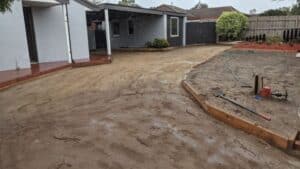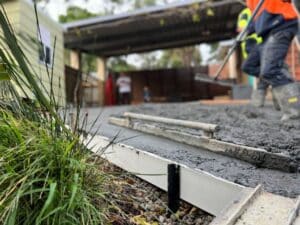The main difference between concrete and cement is that concrete is a building material made by mixing cement, water, and aggregates, while cement is a binding agent used to make concrete. Cement and concrete are often used interchangeably, but they are actually two different materials.
Our professional concreters know that the terms can be confusing for people. In this blog, we’ll expand more on the differences between concrete and cement to fully understand each one.
What Are the Differences Between Concrete and Cement?
Concrete and cement can be differentiated based on the following:
Composition
Cement is a fine powder made by heating a mixture of limestone, clay, and other materials in a kiln at high temperatures. The resulting powder, known as Portland cement, is the most commonly used type of cement in construction. Portland cement is typically composed of about 60% to 65% calcium silicate, 17% to 25% alumina, 3% to 8% iron oxide, and smaller amounts of gypsum, silica, and other minerals.
Conversely, concrete is a mixture of cement, water, and aggregates (such as sand, gravel, or crushed stone). The proportions of these ingredients can vary depending on the application and the desired properties of the concrete.

Function
Cement is primarily used as a binding agent to hold other materials together. When mixed with water, it forms a paste that hardens over time and creates a durable surface. Cement can be used on its own to create surfaces like sidewalks and curbs, or it can be used as an ingredient in other construction materials like mortar and grout.
Meanwhile, concrete is a composite material that can be used for a wide range of construction purposes. In addition to its use as a structural material for building foundations, walls, and floors, it can be used for sidewalks and driveways.
Strength and Durability
Cement is a solid and durable material in its own right, but its strength and durability can be enhanced when it is used in conjunction with other materials. When mixed with water, cement forms a paste that binds the aggregates together in concrete, resulting in a strong and durable material that can withstand heavy loads and extreme weather conditions.
The strength and durability of concrete can be further enhanced by adding various admixtures like fibres, plasticizers, and super plasticizers. These admixtures can improve the workability of the concrete.

Appearance
Cement is a grey or white powder that is typically used as an ingredient in construction materials. Its appearance is not particularly attractive but is not usually visible in the finished product. Concrete, on the other hand, can be coloured or stained to create a wide range of appearances.
Decorative concrete can be stamped, stained, or polished to create a unique and visually appealing finish. It can be made to resemble a variety of materials, including stone, brick, and tile.
Application
Cement is typically used in construction applications that require a strong and durable material, such as building foundations, walls, and floors. It is also used in a variety of other applications, such as making stucco, plaster, and concrete blocks.
Concrete, on the other hand, can be used for a wider range of applications. In addition to its use as a structural material, it is also used for sidewalks, driveways, and parking lots.Want to know the answer to the question, “Is coloured concrete worth getting?” Read our blog to find out.
